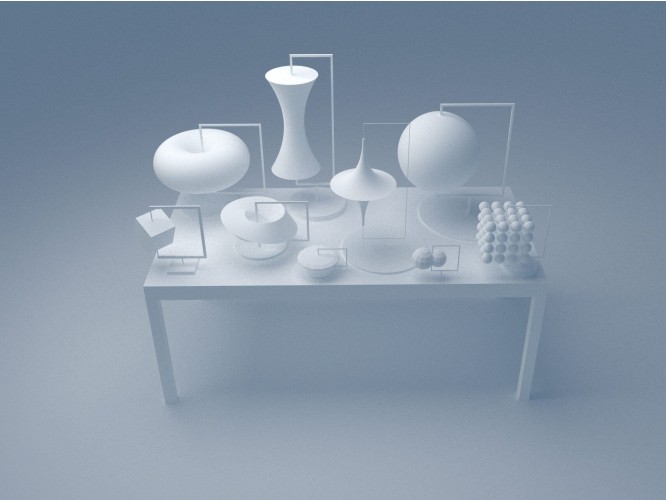Η μυθική Frankfurt kitchen της Margarete Schütte-Lihotzky
DS.WRITER:
Tasos Giannakopoulos
Margarete Schütte-Lihotzky | galeriefutura.de
Ευκαιρία τώρα με τις γιορτές, που περνάμε χρόνο παρασκευάζοντας και καταναλώνοντας φαγητά, τσουρέκια και κουλούρια, να εξετάσουμε την ξεχωριστή περίπτωση της Margarete Schütte-Lihotzky, του ανθρώπου που στην ουσία υπήρξε η μητέρα της εντοιχισμένης κουζίνας που διευκολύνει το γιορτινό τραπέζι, την τυπολογία επονομαζόμενη ως Frankfurt kitchen.
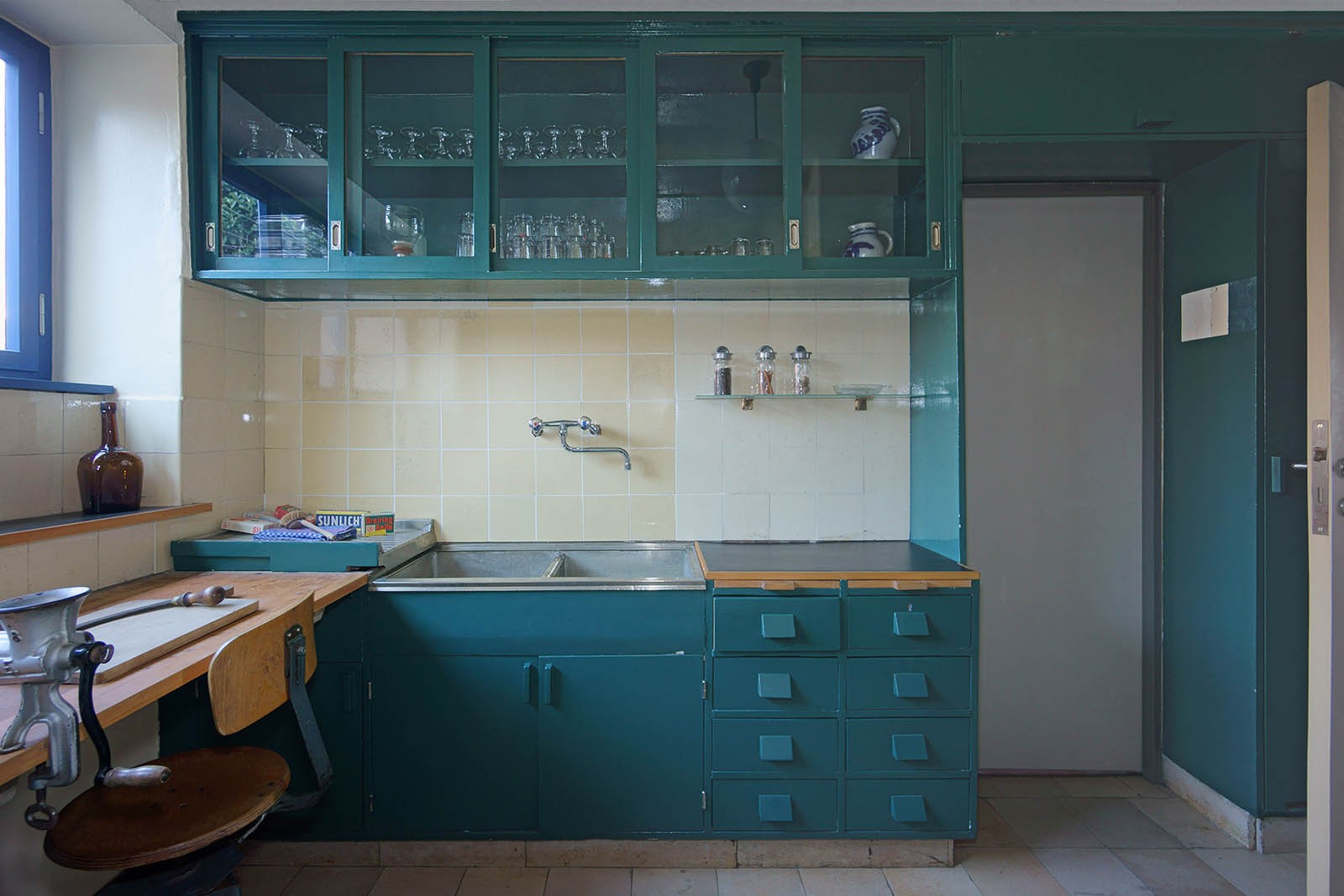
Frankfurt Kitchen | architecturalreview.com
Η Margarete "Grete" Schütte-Lihotzky (1897-2000) ήταν μια Αυστριακή αρχιτέκτονας, και κομμουνίστρια ενεργή στις τάξεις της αντίστασης κατά των Ναζί κατά τον Δεύτερο Παγκόσμιο Πόλεμο, της οποίας η ιδιαίτερη μοίρα της επιφύλασσε να είναι η πρώτη γυναίκα που θα γινόταν δεκτή στην Kunstgewerbeschule -σήμερα University of Applied Arts- της Βιέννης. Ενώ η αυτοκρατορία είχε πέσει κάποια χρόνια πριν, ο συντηρητισμός ήθελε κι άλλο χρόνο, αφού η Lihotzky μπήκε στη σχολή μόνο ύστερα από συστατική επιστολή του διάσημου ζωγράφου Gustav Klimt, ύστερα από την παράκληση της μητέρας της προς τον ίδιο τον ζωγράφο.
Margarete Schütte-Lihotzky | heroinas.net
Η Lihotzky προερχόταν από μια οικογένεια της μεσαίας τάξης, και ύστερα από παρότρυνση του καθηγητή της Oskar Strnad να παρατηρήσει πώς ζουν οι άνθρωποι, και από το ενδιάμεσο σοκ της ποιότητας ζωής της εργατικής τάξης, αποφάσισε να σχεδιάζει για τη μεγάλη πλειοψηφία των ανθρώπων. Η ευκαιρία τής δόθηκε στο κτηριακό πρόγραμμα της New Frankfurt (1925-1930) υπό την καθοδήγηση του Ernst May, όπου η Frankfurt kitchen κατασκευάστηκε σε μαζική παραγωγή και κατέληξε να δημιουργείται σε σχεδόν δέκα χιλιάδες αντίτυπα ως το τέλος της δεκαετίας. Εκεί, οι πιο πρωτοπόροι αρχιτέκτονες ασχολούνται με τον σχεδιασμό οικονομικής, υγιούς στέγασης για τον πληθυσμό, με κατοικίες που θα ανήκουν στην πολιτεία -έργο που στην εποχή των πανάκριβων ενοικίων παραδόξως δεν αφορά πολλούς.
Η κουζίνα που σχεδιάζει είναι εν πολλοίς βασισμένη στον τεϊλορισμό (taylorism), δηλαδή στη λογική της μαζικής σειριακής παραγωγής, και έχει ως στόχο να είναι λειτουργική και οικονομική, αλλά άνετη. Επιδίωκε να είναι ένα σχέδιο χαμηλού κόστους, που θα κατέληγε σε αποτελεσματική εργασία ακολουθώντας την επιστημονική μέθοδο. Αναλύοντας μελέτες χρόνου πάνω στις κινήσεις μιας γυναίκας στον χώρο της κουζίνας, η Lihotzky με σαφή επιστημονική κατεύθυνση επιδιώκει να ελαφρύνει τον κόπο στον συγκεκριμένο χώρο, μειώνοντας τις απαραίτητες κινήσεις στο ελάχιστο. Από τη μία, ο χώρος που διαθέτει ένα κινητό καρότσι δείπνου και επιφάνειες σε κατάλληλη θέση, ώστε η προετοιμασία του φαγητού να γίνεται γρήγορα και απρόσκοπτα, μεταμορφώνεται σε ένα αληθινό εργαστήριο ενός πραγματικού τεχνικού, με ξεχωριστές θέσεις για κάθε υλικό απαραίτητο στη μαγειρική επιστήμη. Από την άλλη, το ίδιο το άτομο που χειραγωγεί με αποτελεσματικότητα τον χώρο και τα εργαλεία του, η γυναίκα δηλαδή, δεν αναγνωρίζεται με την ίδια αξία, δηλαδή αυτή του τεχνικού.
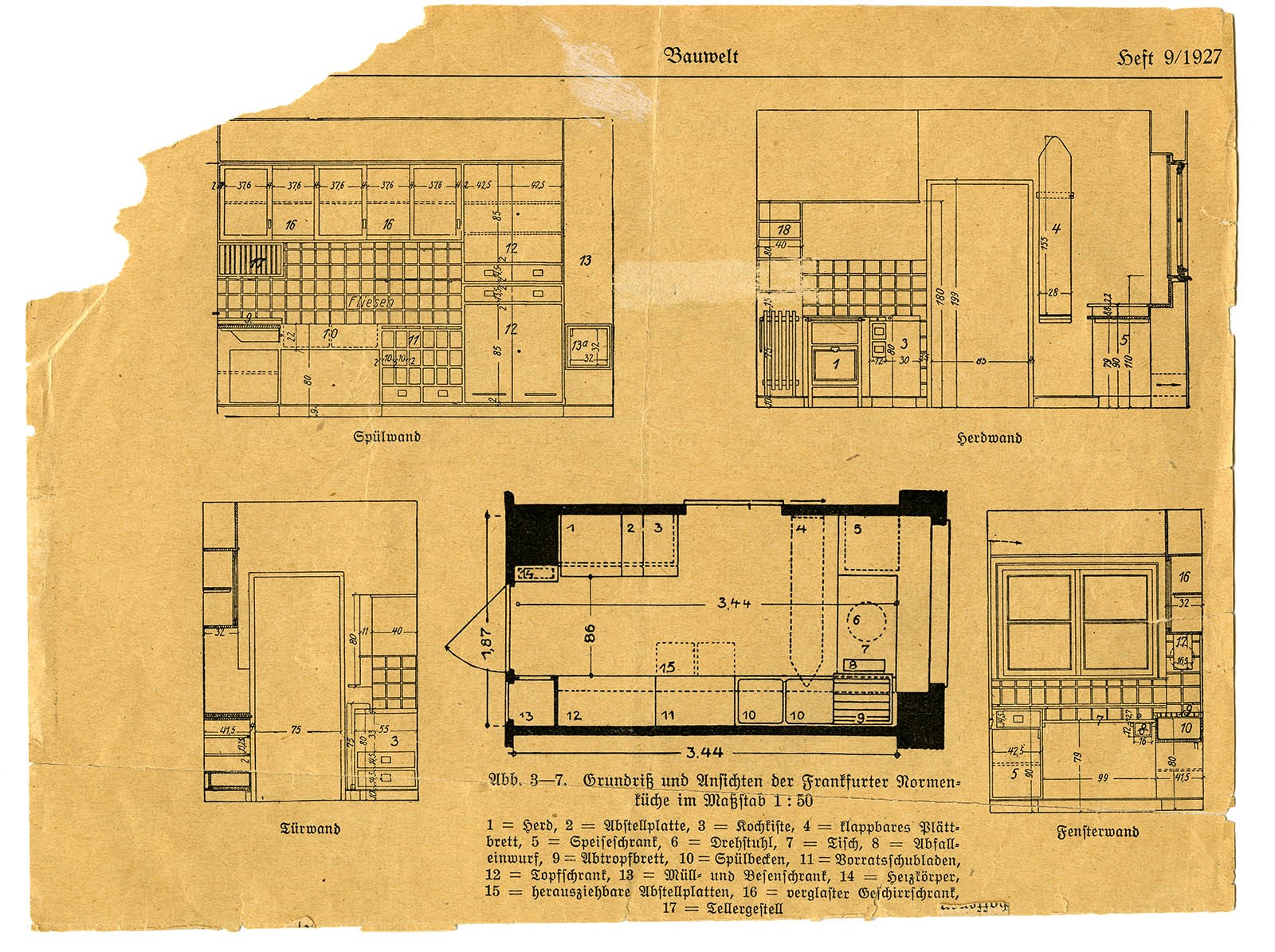
Frankfurt Kitchen Drawings | architecturalreview.com
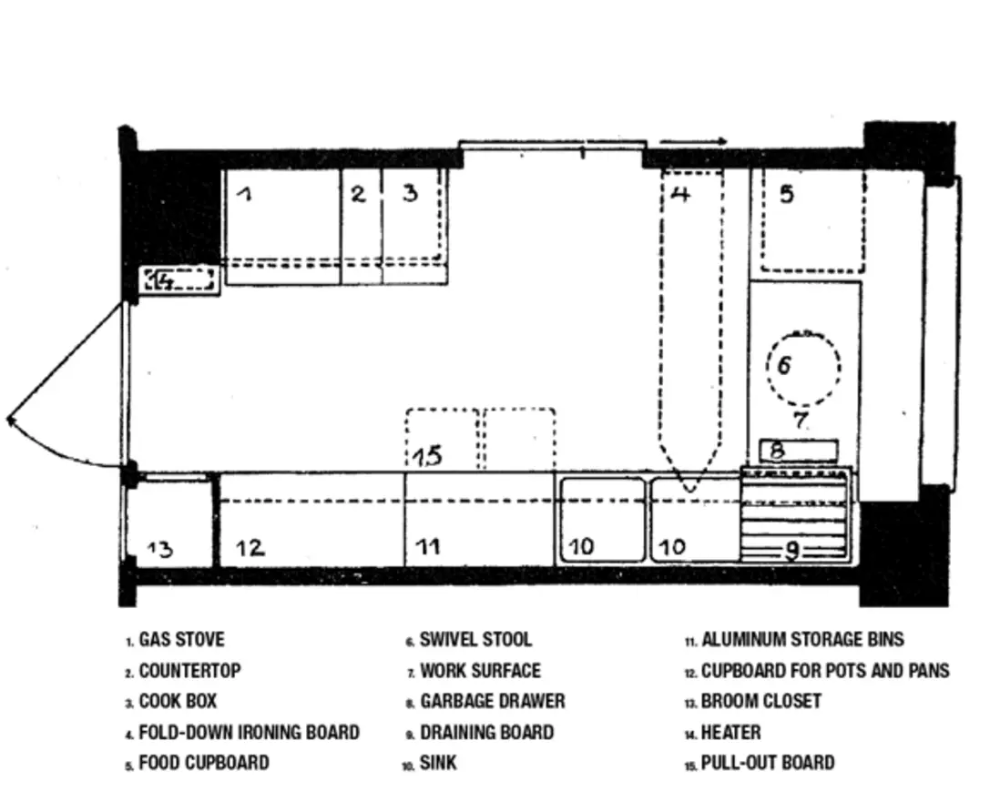
Frankfurt Kitchen Plan | pinimg.com
Η Frankfurt kitchen είναι ένα έργο με αρκετές αντιφάσεις. Όπως αναφέρει η Gwendolen Webster, η Lihotzky γράφει πως την πίεσαν να γίνει το πρόσωπο της κουζίνας της Φρανκφούρτης, ώστε να προωθηθεί η ιδέα της κουζίνας “από γυναίκα, για γυναίκα”, το οποίο ακούγεται αρκετά σύγχρονη διαφημιστική καμπάνια. Αλλά, ακόμη και αν η συνεισφορά της ήταν λιγότερη από τις μυθικές διαστάσεις που έχει λάβει, η Αυστριακή αρχιτέκτονας ήταν σίγουρα το πρόσωπο που εδραίωσε με τις δημόσιες τοποθετήσεις και τον δημόσιο λόγο της τη Frankfurt kitchen. Ακόμη μια χαρακτηριστική αντίφαση που διαμορφώνεται με το έργο, είναι ο χρόνος που ισχυρίζεται πως εξοικονομεί αυτή η συγκεκριμένη τυπολογία. Καταλήγει να εξυπηρετεί στη χειραφέτηση της γυναίκας παρέχοντας τον χρόνο της σε πιο ελεύθερες δραστηριότητες, ή εξοικονομεί χρόνο ώστε να είναι πιο αποτελεσματική στην εργασία της στο εργοστάσιο; Ή μήπως η συρόμενη πόρτα που τη διαχωρίζει από την υπόλοιπη ζωή του σπιτιού, περιχαρακώνει τον ρόλο της γυναίκας ακόμη πιο στέρεα μέσα στην κουζίνα;
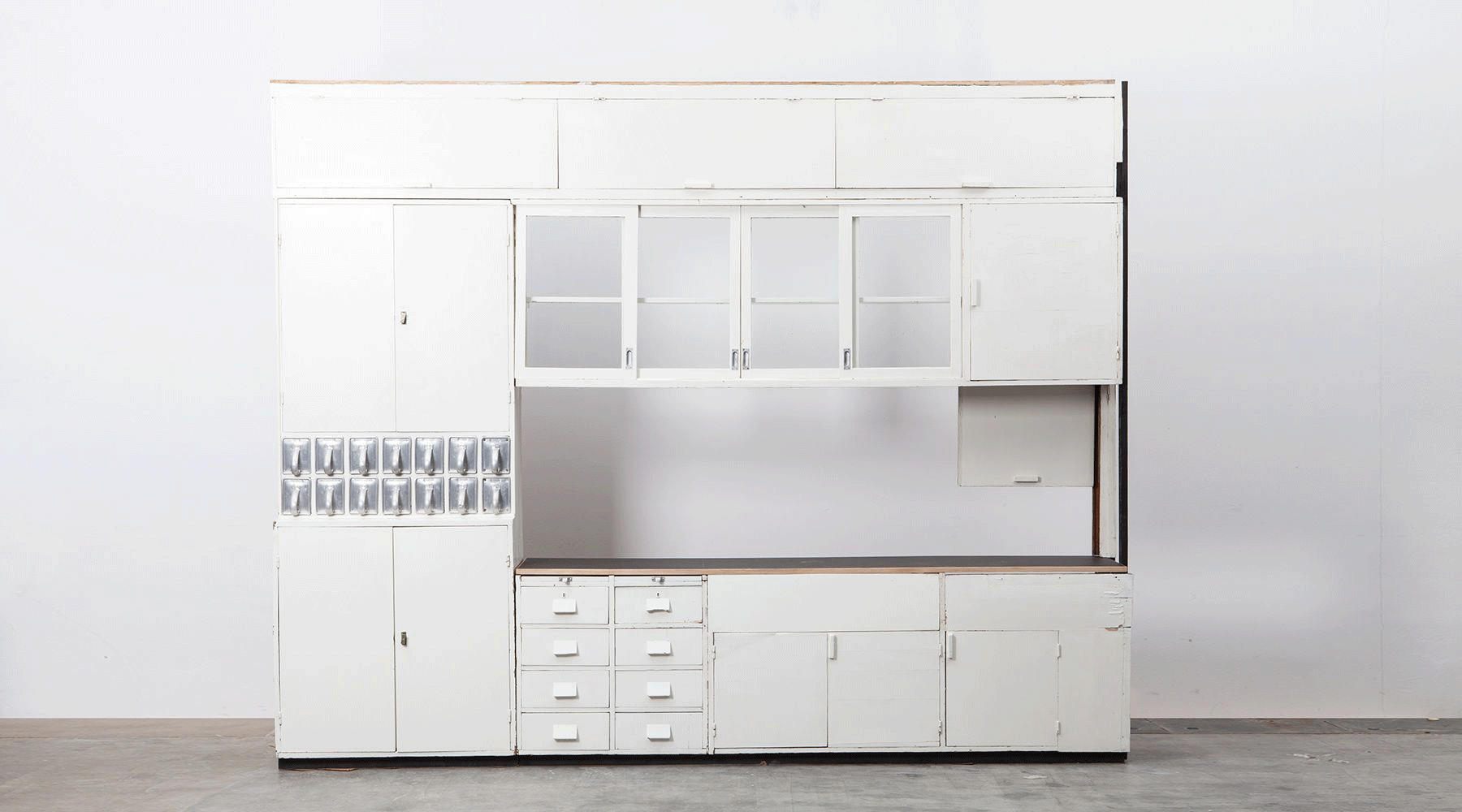
Frankfurt Kitchen Model | archinect.net
Η απάντηση μέσα σε λίγες γραμμές τέτοιων ερωτήσεων μοιάζει τουλάχιστον αφελής και, ευτυχώς ή δυστυχώς, η δύναμη της αρχιτεκτονικής και του design μοιάζει περιορισμένη και για να δημιουργήσει τέτοια προβλήματα κοινωνικών δυναμικών, αλλά και για να τα λύσει. Το μόνο βέβαιο είναι πως η Margarete Schütte-Lihotzky αποτελεί πρότυπο σχεδιαστή που θέλει να ελαφρύνει τον ανθρώπινο πόνο και να μην τον χρησιμοποιήσει μονάχα για ηθικό κεφάλαιο και κοινωνική ανέλιξη. Και, καταλήγοντας με αντιφάσεις, ο τρόπος που μαγειρεύουμε μεταμορφώθηκε για πάντα εξαιτίας της, ακόμη και αν η ίδια δεν μαγείρευε ποτέ.





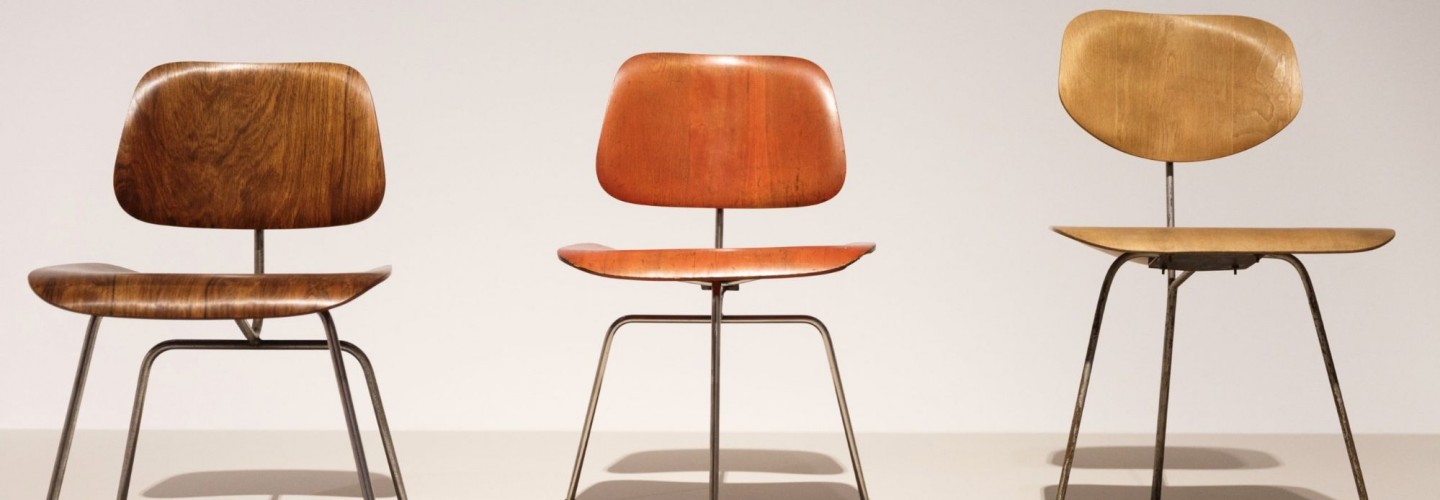
.jpg)

